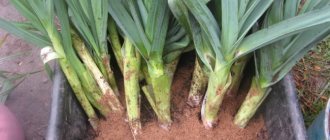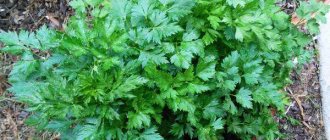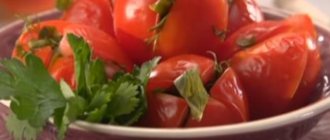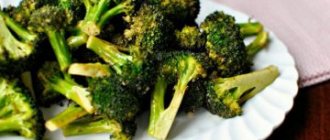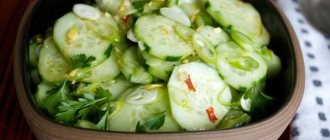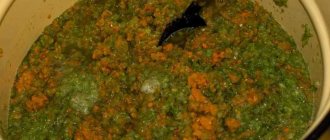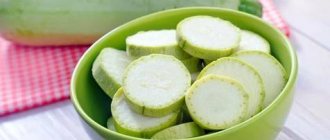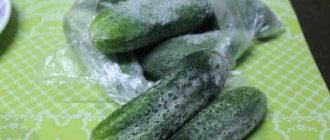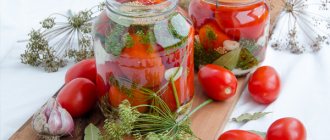What is the difference between frozen greens and fresh ones?
Vitamins and minerals are not afraid of negative temperatures, so they are preserved in frozen greens in their entirety. The only exception is ascorbic acid, the content of which decreases by only 10% over six months. For example, 100 g of fresh parsley contains 150 mg of vitamin C, and after 6 months after freezing it will contain about 137 mg, which is 150% of the daily intake of this vitamin.
Scientific studies have shown that homemade frozen greens contain much more microelements than fresh greens brought from warm countries in winter. In Spain, Turkey and Israel, vegetables and herbs are grown in poor soils and treated with large amounts of chemicals, so they have questionable benefits.
The calorie content of frozen parsley is practically the same as fresh. 100 g of frozen greens contains:
- 50 kcal;
- 4 g proteins;
- 0.5 grams of fat;
- 7.7 g carbohydrates.
Frozen parsley is rich in:
- Vitamins B, A, E, PP, K, retinol, ascorbic and nicotinic acids.
- Minerals:
- manganese;
- selenium;
- copper;
- phosphorus;
- calcium;
- potassium
- Essential oils.
- Antioxidants.
Benefits of freezing greens
Parsley is an addition to dishes. But its fresh greens are available only in season. As a rule, this is only a few months a year. There are ways to prepare aromatic leaves for the winter: with salt in jars, in the freezer, or in dried form. Each of them has pros and cons. Let's look at the advantages of frozen storage:
- Freezing, unlike drying, takes much less time. All you have to do is choose the packaging, the grinding method and place the product in the freezer. Drying is possible only under certain conditions of temperature and humidity and requires attention for several days in a row.
- Preservation of vitamins. During freezing, beneficial substances are preserved almost unchanged.
- The aroma and color of the seasoning remain unchanged. It looks more aesthetically pleasing in various dishes. And the original taste of parsley reminds of summer.
Some may object to the relevance of storing frozen greens. However, greens sold in supermarkets all year round are fertilized with mineral supplements. And they, in turn, are harmful to health.
By freezing greens from your garden, you can be sure of their safety. This way, not only will vitamins be preserved as much as possible, but there will also be no harmful chemical impurities.
Benefits and harms
Greens from the freezer have a powerful effect on the body, namely:
thanks to essential oils, it has antiseptic and anti-inflammatory properties;
- vitamin K strengthens blood vessels and prevents the formation of blood clots;
- improves vision due to the content of vitamin A and beta-carotene;
- regulates the functioning of the endocrine system;
- increases metabolic rate and promotes weight loss;
- vitamin B2 and folic acid maintain a normal nervous system;
- removes excess salt from the body and prevents joint diseases;
- cleanses the intestines and promotes the development of healthy microflora;
- ascorbic acid strengthens the immune system and protects against colds;
- due to the content of a large amount of chlorophyll, it improves blood properties;
- regulates blood sugar levels;
- Vitamin E prevents the smallest capillaries from clogging;
- the amino acid histidine stimulates the restoration and healing of all body tissues;
- a high concentration of potassium strengthens the heart and helps stabilize the heartbeat;
- nicotinic acid improves digestion and redox processes;
- parsley contains phytoestrogens, which normalize the menstrual cycle in women;
- prevents the development of prostatitis in men, improves potency.
You can learn more about the medicinal properties of parsley here.
Harm of frozen parsley:
- Parsley is very susceptible to environmental conditions.
If greens are grown in areas with unfavorable environmental conditions, or with the use of chemicals, the crop will do more harm than good. Heavy metal salts and other toxic substances cannot be completely removed from the beam. - Spicy greens are contraindicated for people suffering from liver and urinary tract diseases.
- Excessive consumption of frozen parsley leads to an excess of essential oils in the body, which leads to dizziness and nausea.
Is parsley good for animals? This article will tell you in this article.
What can be made from parsley. What is parsley useful for and its use in folk medicine
Parsley is a spicy aromatic plant that improves the taste of food.
Greece is considered the birthplace of parsley, where it grows wild. The name parsley may have come from its ability to grow on rocky soil (“petr” means “stone” in Greek).
In the middle of the 14th century, it was bred in the monastery gardens of Europe as a spicy and medicinal plant.
In Rus', parsley has long occupied a place of honor in folk medicine: the leaves were used to heal wounds and inflammations, improve vision, strengthen gums, reduce freckles with juice, the roots and leaves were used as a diuretic for dropsy, edema and kidney stones.
What does parsley contain and what are its beneficial properties? This plant contains many vitamins (B, B3, B5, C, E, K), beta-carotene, biotin, folic acid, iron, iodine, potassium, calcium, magnesium, manganese, selenium, phosphorus, zinc. Parsley, rich in vitamins and microelements, is extremely useful for chronic fatigue. 100 grams of young green parsley shoots contain approximately two daily requirements for vitamin C. This is 4 times more than the same amount of lemons, and 10 times more than lettuce leaves. In terms of carotene content, parsley is not inferior even to the generally recognized champion - carrots.
How does parsley affect the body, and what diseases is it used to treat? Juice and decoction made from parsley leaves are indispensable for vitamin deficiency. In addition, they help strengthen blood vessels and are effective for acute and chronic cystitis.
What else is parsley useful for, and how can it be used? Infusions and decoctions are prepared from parsley root, which are used for kidney stones, inflammation of the prostate gland, edema of the heart and kidneys, and obesity.
Chewing fresh parsley root can completely eliminate bad breath.
All stages: how to prepare greens for storing in the freezer?
Freezing is the only way to preserve all the beneficial substances in parsley for a long time . The best greens are those that have just been brought from the garden. If it is not possible to grow the spice yourself to freeze for the winter, you can buy it at the market or in a store.
When purchasing parsley, you need to make sure that it was grown in the buyer’s area of residence. Greens that were cut a long time ago and brought from afar have already lost all their vitamins. Also, the bunches should not have dried or damaged areas. The color of a fresh bunch is bright and uniform.
To freeze parsley you will need: a sharp knife, a cutting board, a dry soft towel, plastic bags or containers. Steps:
- The washing up . The greens must be thoroughly washed in cold running water to remove all dirt and dust. Under no circumstances should you wash greens with hot water - after such treatment, all vitamins and minerals will be destroyed.
- Drying. This step cannot be skipped, otherwise the parsley in the freezer will become covered with an ice crust.
- It is necessary to allow the water to drain from the branches, placing the greens in a colander.
- When the main water has drained, you need to lay the crop in a thin layer on a dry towel and leave for 2 hours.
- Slicing.
- You need to finely chop the parsley, so it will be very convenient to use in the future.
- After cutting, the greens are once again spread in a thin layer on a towel for 2 hours.
- Cooling . Place the spice on a cutting board or tray and place in the freezer for 4-5 hours. Once cooled, the chopped greens will become crumbly.
- Freezing. Chilled parsley should be packaged in small airtight containers or bags.
The smaller the container, the less frozen greens will come into contact with warm air each time the container is opened. The optimal temperature in the freezer is - 18°C.
If you skip this step, the parsley will clump in the freezer.
Experienced housewives advise packaging the spice into portioned bags and putting in each of them as much as is usually used for one-time preparation of a dish.
This way, the parsley will not come into contact with either warm air or foreign odors, and will be preserved for a long time.
Frozen parsley will delight you with its taste and vitamins all year round.
Selecting and preparing parsley for freezing
Housewives often ask whether it is possible to freeze parsley for the winter. Where do such doubts come from? Any greenery tolerates low temperatures well. This is one of the best ways to stock up on vitamins in the summer. Limp, soggy, tasteless grass is just the result of wrong actions.
Benefits of freezing:
- ease of preparation;
- preservation of aroma, taste, color;
- many ways.
Flaws:
- elasticity is lost;
- easy to spoil;
- container and space required.
With a competent approach, disadvantages can be easily minimized. It is important to learn how to prepare, defrost, and use according to all the rules. Let's start by preparing the greens.
Instructions:
- We collect in the evening or in the morning if there is no dew. We choose young twigs and tender leaves.
- Rinse under the tap or in a bowl of cold water, shake off excess drops.
- Let's dry it. Simply lay it out on a flat surface in a thin layer and pre-lay it with fabric. Some types of freezing do not require drying.
- Cut off the branches. It is recommended to remove long stems. Leaves behave better when frozen.
To eliminate insects and larvae, we recommend soaking the greens for half an hour in salted water. The same method is used to remove nitrates.
Is it permissible to re-store the spice in the cold?
Greens should not be re-frozen. Cell membranes, weakened by repeated freezing and thawing, burst, and the vitamins and minerals contained in the cells are destroyed. Parsley, once re-frozen, does not provide any benefit to the body.
Read about the varieties of parsley, how it differs from cilantro and celery, the characteristics of the seeds and the ban on the curly variety in Russia on our website.
Frozen parsley is a summer vitamin “hello” for winter soups and salads. Frozen aromatic spice does not differ in taste and benefits from fresh bunches . The main thing is to accurately follow all the stages of preparing and freezing parsley, and the vitamin seasoning will last until spring.
What kind of parsley is suitable?
For freezing, only bright green herbs should be selected, without diseases or mechanical damage. The plant must be fresh. For example, when stored in the refrigerator for 3 days, parsley loses up to 50% of its beneficial vitamins. For the same reason, it is not advisable to buy greens for freezing; it is better to use your own, freshly picked.
An important nuance: in most supermarkets, greens are deliberately highlighted to make them look fresher. You should not buy parsley for freezing in such places.
We invite you to familiarize yourself with: Monarda: photos, planting and care in open ground
Methods for preparing parsley for the winter
For every housewife there are recipes that suit her preferences and wishes. You just have to search a little. Creating suitable home conditions for preparations is not difficult. And the resulting seasoning compensates for all the effort expended.
The entire plant is harvested for the winter; there are not many ways to accomplish this task:
- Drying. The roots and leaves of plants are dried in the oven or in the fresh air.
- Freezing. The crushed parts of the culture are frozen and stored in the freezer.
- Marinating or salting. Chopped greens and chopped roots are pickled or salted.
- Oiling. The workpiece is mixed with oil and stored in the refrigerator.
You should choose a method of preserving the culture by studying the recipes.
Dried parsley
There is nothing difficult about drying parsley. It is enough to fulfill a few requirements, and everything will work out.
How to dry a plant and preserve the aroma is a question many housewives ask. Compliance with the requirements and rules results in parsley retaining not only its odors, but also its mineral components.
The advantages of this method are that the parsley loses weight and becomes more compact. And it is easier to store it, and it does not require special conditions.
To prepare green mass or roots for future use, they are washed and dried well. Then they sort through, removing unsightly, diseased and deformed specimens. At the end of sorting, the roots are cleaned.
The roots, depending on the size, are cut into circles or cubes. The prepared raw materials can only be dried. They do this in different ways.
On open air
This method takes a long time, but the effectiveness does not suffer from this. Greens are dried whole sprigs or chopped for immediate consumption.
To dry, it is placed on a plane, evenly distributed over the surface on which it is dried. The thinner the layer, the faster the raw material will dry. Lay out no more than 1 centimeter thick.
The greens collected in bunches are hung under a canopy or in another well-ventilated area. The leaves should hang down. It is advisable to exclude direct sunlight on the foliage, as it will turn yellow and lose its attractiveness.
We suggest you read: How to store potatoes in winter on a balcony without heating and with it: at what temperature is this realistic, and also is it possible to place the tubers in a cardboard box
The roots are also dried in the fresh air, cut into arbitrary shapes and covered with gauze to prevent insects. Periodically turning the pieces will speed up the drying process and eliminate scorching.
Depending on the accompanying conditions, the plant will have to dry from 5 to 20 days, not forgetting to periodically turn the raw materials to speed up the process.
In the oven
It doesn’t take much time to prepare the spice this way. The seasoning will dry out much faster than in the first case.
It is important here not to overdo it with the temperature, because the higher it is, the faster the roots and greens dry. But this affects the appearance and the complex of useful substances included in their composition.
The optimal temperature is 40-60 ⁰С. The washed and peeled roots are cut into cubes or slices and laid out on a baking sheet. The greens are laid out in sprigs or cut and distributed in a thin layer.
Dry with the door open, the approximate time spent in the oven is 5-6 hours. Finely chopped raw materials dry several times faster.
In an electric dryer
This kitchen assistant will always help out the housewife. You don’t have to do anything special, the roots need to be cut, and the green branches should be laid out whole.
Set the “For herbs” mode, and set the temperature to no more than 45 ⁰C. It is necessary to periodically monitor the process, changing places of pallets. It is difficult to indicate the exact time; it depends on related factors: air humidity, slice thickness and much more.
In the microwave
Place the parsley on a plate, preferably flat, and cover the bottom with a napkin. The power of the device is maximum. The time for which the raw materials are placed in the microwave is 2 minutes, then you should look at the appearance of the plant. If it is not dry enough, leave it for another 2 minutes. And so on until the mass reaches the desired state.
Pickling parsley
An effective way to preserve crops for the winter is to sprinkle them with salt. There are many recipes for its preparation. It is necessary to select the most suitable method.
You can preserve parsley for the winter at home in different ways:
- whole in bundles or in a plastic container;
- in ice trays;
- in a plastic bag or in small portioned bags.
Each housewife chooses the method that will allow her to take some greens for cooking.
Preparing parsley for the winter by packaging it in bags is simple: you need to prepare it and put it in the freezer. To preserve the aroma and appearance of the plant, several conditions must be met.
It is important that the harvested greens are pre-dried. You should not freeze washed but wet grass, as it will lose its attractive appearance. Water in the freezer will turn the parsley into an icy lump, making it difficult to use in cooking.
Advice!
Parsley, which is packaged in bags, must be chopped. You need to remove the stems of the plant and finely chop the fresh leaves. This aromatic seasoning can be added to soups, hot main courses or used to prepare decoctions.
Might be interesting
It is better to make the blanks small. It is convenient for storage and cooking. When the freezer is large and contains a lot of food, it can be difficult to find what you need to prepare a dish: different greens look the same, and parsley can easily be confused with dill or cilantro. To prevent this from happening, the blanks must be signed. Take a piece of paper, write on it the type of plant and the date of freezing and put it in a bag, so you don’t confuse one seasoning with another.
You can store greens in bags in different ways:
- portionwise, measuring the required number of grams, which is used to add to the dish;
- large mass in a bag with a plastic zipper;
- a large mass in a bag without a fastener, rolled into a roll and secured with an elastic band.
You can store parsley in the frozen food compartment of the refrigerator as ice cubes. For this method, the greens must be prepared first, but you don’t have to dry them, since they will be filled with water into the molds.
- Prepare ice trays. If there are no special plastic containers, then anything with small and deep cells will do, for example, plastic substrates from boxes of chocolates.
- Finely chop the parsley leaves and stuff them tightly into the freezing dish.
- Fill the cells with greens with filtered or boiled cold water and put them in the freezer.
- After freezing, the ice cubes can be transferred to a plastic bag or, if space allows, left in the molds.
- Label the container with herbs.
We suggest you familiarize yourself with: The best types and styles of bonsai
Ice cubes with parsley can be used to wipe your face or use them in cooking. If you add a drop of any vegetable oil to each cube while preparing greens for freezing, such preparations can be added to cooked dumplings, porridges or salads.
When asked whether it is possible to freeze parsley in bunches, we answer yes, you can. This method is the simplest. To keep parsley fresh for the winter, just sort it out, dry it and roll it into small bouquets that can be used immediately after defrosting:
- dry the greens well;
- wrap several branches in cellophane;
- to freeze;
- Place in a labeled plastic container.
Advice!
There is no need to refreeze greens that were not used in cooking. It will lose its appearance and aroma (it is difficult to preserve the aroma of fresh parsley the second time).
